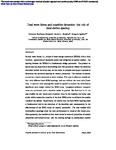Dual wave farms and coastline dynamics: The role of inter-device spacing
| dc.contributor.author | Rodriguez-Delgado, C | en |
| dc.contributor.author | Bergillos, RJ | en |
| dc.contributor.author | Iglesias, G | en |
| dc.date.accessioned | 2018-09-17T08:20:27Z | |
| dc.date.issued | 2019-01-01 | en |
| dc.identifier.issn | 0048-9697 | en |
| dc.identifier.uri | http://hdl.handle.net/10026.1/12369 | |
| dc.description.abstract |
© 2018 Elsevier B.V. In dual wave farms, i.e., arrays of wave energy converters (WECs) with a dual function – generation of renewable power and mitigation of coastal erosion – the spacing between the WECs is a fundamental design parameter. The present research has the objective of establishing how this parameter affects the shoreline evolution behind the array and, on this basis, to propose and apply a method to determine the optimum spacing for coastal protection. The method is demonstrated on a beach subjected to severe erosion. Five case studies are considered: four with different inter-WEC spacings, and one without the wave farm (baseline). A spectral wave propagation model is applied to analyse the variations in significant wave height behind the WEC array. Longshore sediment transport rates are calculated, and a shoreline model is applied. We find that in all the case studies the dry beach area is greater than in the baseline (no farm) case study, which proves the capacity of the dual WEC array to mitigate the erosive trends of the system. Importantly, we obtain that the inter-WEC spacing plays a fundamental role in the evolution of the shoreline and, consequently, in the effectiveness of the WEC array for coastal protection. The case studies with intermediate spacings yield the best performance in terms of dry beach area. More generally, the benefits of dual wave farms in terms of protection of coastal properties and infrastructure, and the ensuing savings in conventional coastal defence measures (coastal structures, beach nourishment, etc.) contribute to the development of wave energy by enhancing its economic viability. The methodology presented in this paper can be used to optimize the design of dual wave farms elsewhere. | en |
| dc.format.extent | 1241 - 1252 | en |
| dc.language.iso | en | en |
| dc.publisher | Elsevier | en |
| dc.title | Dual wave farms and coastline dynamics: The role of inter-device spacing | en |
| dc.type | Journal Article | |
| plymouth.volume | 646 | en |
| plymouth.journal | Science of the Total Environment | en |
| dc.identifier.doi | 10.1016/j.scitotenv.2018.07.110 | en |
| plymouth.organisational-group | /Plymouth | |
| plymouth.organisational-group | /Plymouth/Faculty of Science and Engineering | |
| plymouth.organisational-group | /Plymouth/Research Groups | |
| plymouth.organisational-group | /Plymouth/Research Groups/Marine Institute | |
| plymouth.organisational-group | /Plymouth/Users by role | |
| dcterms.dateAccepted | 2018-07-09 | en |
| dc.rights.embargodate | 2019-12-07 | en |
| dc.identifier.eissn | 1879-1026 | en |
| dc.rights.embargoperiod | Not known | en |
| rioxxterms.versionofrecord | 10.1016/j.scitotenv.2018.07.110 | en |
| rioxxterms.licenseref.uri | http://www.rioxx.net/licenses/all-rights-reserved | en |
| rioxxterms.licenseref.startdate | 2019-01-01 | en |
| rioxxterms.type | Journal Article/Review | en |


